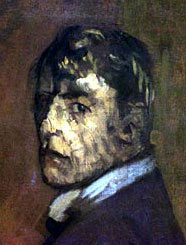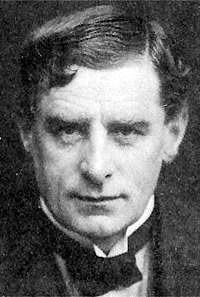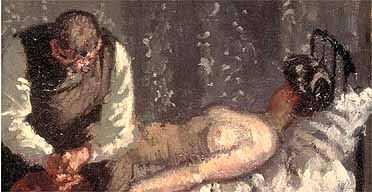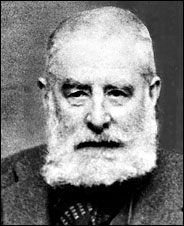I found this dissertation interesting. It provides an answer to several of the author's assertions. I included the link at the end of the article.
Patricia Cornwell's upcoming book, Portrait of a Killer: Jack the Ripper - Case Closed is without a doubt the single most publicized book ever released in the history of the genre. As such, it has the potential to impress the minds of millions worldwide with certain ideas about the Ripper crimes which are, unfortunately, largely inaccurate. The purpose of this primer is not necessarily to refute Ms. Cornwell's theory, but to provide an easy-to-follow factual guide for readers new to the subject who would like to know more about the facts presented in her book.
Those who have not yet read the book are hereby warned that the following primer may include spoilers.
Concept #1: Jack the Ripper sent taunting letters to the police and media during the murder spree.
This concept is an important one, and it forms the foundation of Ms. Cornwell's thesis, namely, that Walter Sickert was Jack the Ripper. Cornwell's team of forensic scientists found a sequence of mitochondrial DNA (mtDNA) on several "Ripper letters" which matched sequences found on several letters written by Sickert. Specific watermarks were also matched in both Sickert's letters and those sent to the police and media. If these findings are accurate, then, according to Cornwell, Walter Sickert was Jack the Ripper.
Unfortunately, its not quite that simple.
Fact #1: Most, if not all, of these "Ripper" letters are considered to be hoaxes.
The Metropolitan and City Police, as well as several news agencies, did indeed receive hundreds of letters in 1888 and the years following, in which the author either claimed to have been the Whitechapel murderer or offered advice on how to catch the killer. The exact number of these letters is unknown, but there are approximately 600 in total known to survive today. Indeed, Scotland Yard claims to have received letters like this up until the mid-1960s. Many of these letters were mailed from London itself, but many more were mailed from various portions of the U.K., as well as from France, the United States, Australia, South Africa, and many other foreign countries.
Obviously, one person could not have written all or even most of these letters. Indeed, the handwriting, grammar, spelling and tone of these communications vary greatly from one letter to another. Some are written in a shaky scrawl, others in a fine penmanship. Some are riddled with spelling errors and appear to have been the work of an illiterate. Others are thoughtfully written - in some cases, downright poetic. Several modern works have addressed this voluminous correspondence, including "The Whitechapel Murders Papers," a set of microfiche archiving hundreds of these letters, and more recently Jack the Ripper: Letters from Hell, a lavishly illustrated book by Stewart P. Evans and Keith Skinner.
The fact was that hoaxing Ripper letters in 1888 had become something of a sick, national past-time. Today we suspect that certain journalists working within the Central News Agency may have been responsible for hoaxing the first few, widely-publicized "Jack the Ripper" letters (namely the "Dear Boss" letter, and possibly the "Saucy Jacky" postcard). More than one police official publicly stated that a journalist named Tom Bulling was believed responsible for the original hoaxes. These early letters were reproduced on broadsheets and in newspapers, and fueled the panic into a near frenzy. Unfortunately, they also seemed to have struck a chord in countless individuals who soon after felt compelled to send in hoaxes of their own - in many cases, modeled after those original letters sent to the Central News Agency. Crass attempts at copying the grammar of those letters resulted in the continual reappearance of phrases like "Dear Boss", "Yours Truly", "I love my work" and, of course, the name "Jack the Ripper."
We know of at least two people who were arrested and charged for hoaxing Ripper letters. Interestingly enough, both were women. The first was a woman from Bradford named Maria Coroner, the second was a Miriam Howells from Penrhiwceiber. There were, of course, countless others.
Only one letter, interestingly enough not signed "Jack the Ripper," is considered to be possibly written by the murderer. Called today the "From Hell" letter, it was received by George Lusk approximately three weeks after the murder of Catherine Eddowes, accompanied by a small piece of human kidney. The author of the letter claimed the kidney was from Eddowes, and that he "fried and ate" the other half. One of her kidneys was indeed removed and taken away by her killer, so on the face of it, it would appear the letter has to be genuine. However, medical tests could not conclusively state that the kidney enclosed was indeed the same as the one taken from Eddowes three weeks before. The possibility remains that the From Hell letter and kidney were the result of misguided prank by a medical student (a fairly common thing in those days).
The "Openshaw" letter, which according to Cornwell provided similar mtDNA sequences and watermarks to those found in Sickert's correspondence, has never been considered a genuine Ripper letter by any serious author or researcher. It was sent to Dr. Thomas Horrocks Openshaw, who was widely publicized in the newspapers for having examined the piece of kidney enclosed along with the "From Hell" letter.
In the end, Ms. Cornwell's mtDNA and watermark evidence (which we will discuss a little later) may indicate that Walter Sickert hoaxed one or more Ripper letters, but that remains a far cry from conclusively linking Sickert to the Ripper murders. The only Ripper letter with a strong possible connection to the true murderer is the "From Hell" letter, and Cornwell found no links in the text of this letter between the author and Walter Sickert. (The original no longer survives, however, so DNA/watermark testing would have been impossible.)
Concept #2: Patricia Cornwell has found conclusive DNA evidence linking Walter Sickert to one or more "Jack the Ripper "letters.
Patricia Cornwell's forensics team performed DNA testing on the backs of envelopes and stamps from the "Ripper" correspondence, as well as from Sickert's own correspondence. It should be stated from the beginning that DNA testing of material over a century old has never before been done. Nuclear DNA tests - the usual form of DNA testing - came back negative. The forensics team then attempted mitochondrial DNA (mtDNA) testing, which provided some results. Similar "sequences" of mtDNA were found in both the "Ripper" correspondence and the Sickert correspondence.
Fact #2: The mtDNA results do not state that Walter Sickert was the author of those Ripper letters. They state only that the person who left DNA on Sickert's correspondence can not be eliminated from the percentage of the U.K. population who could have provided an mtDNA match. Walter Sickert's DNA no longer exists - he was cremated after his death.
Before we begin to discuss the actual interpretation of the mtDNA evidence, it is important to understand that the documents being tested were in most cases over a hundred years old. Most, if not all of them have been handled countless times by family members, archivists and researchers over the years, and so DNA contamination can be considered a serious problem. Little mention of this possible contamination is made in Cornwell's book.
mtDNA found on any particular letter may not necessarily have come from the author. Aside from possible contamination, we do not know for sure that Sickert licked his own stamps and envelopes. This may seem a silly point, but as Cornwell herself states, it was common practice in Victorian times to use a moist sponge for the practice, for fear of germs and bacteria. Also, if it is true as Cornwell herself suggests, that Sickert had several of these letters mailed for him by other people, then it must be taken into consideration that the envelopes and stamps may have been moistened by someone else's saliva.
So already there are several points of contention which may or may invalidate any form of DNA testing on stamp/envelope residue, since there is no concrete proof that DNA left on those letters actually came from Walter Sickert. But let's ignore that for now and examine the mtDNA results themselves.
mtDNA is different from nuclear DNA in that it is transmitted matrilineally. That means that child inherits his or her mtDNA directly from her mother - none of the father's mtDNA is replicated in his children. This is important when attempting to find DNA matches between parents and children, or between siblings, but in our case, Cornwell is simply trying to match Walter Sickert to Walter Sickert, so it shouldn't matter. mtDNA testing is used by many forensics labs for identification and should be considered as valid a method as nuclear DNA testing. It is, however, a much less specific method of testing - mtDNA, unlike nuclear DNA, is not unique. Finding an mtDNA match between two samples does not mean that one person left both, but that only a certain percentage of the population could have left both.
The mtDNA testing done by Cornwell's team found similar "sequences" of mtDNA. What does that mean? No one mtDNA sequence is unique. An mtDNA sequence found in Person A may also be found in Persons B and C, regardless of whether or not they are related by blood. This is similar, for example, to blood typing - persons completely unrelated to each other and living on opposite sides of the planet can still have the same blood type. In this case, the mtDNA "sequences" found indicate, according to Cornwell, that only 1% of the population of the U.K. could have left the DNA found on those Ripper letters, and that the person who left DNA on Sickert's correspondence was a member of that 1% population. (Other DNA experts, when asked to comment on this analysis, state that the actual percentage could range anywhere between 10% and 0.1% of the contemporary population). In 1901 there were nearly 40 million people in the United Kingdom. That means that Sickert, if we assume it is his mtDNA that was found, and that Cornwell's figure of 1% is correct, was one of approximately 400,000 people whose mtDNA shared those same sequences.
This is certainly not conclusive evidence - it would never stand up in a modern-day courtroom - but it is, as Cornwelll says, "a cautious indicator." Still, it should be noted that her own DNA specialist said that it could very well be just a matter of coincidence.
In the end, although the evidence is certainly not iron-clad, it can be considered suggestive. Ignoring the various pitfalls of contamination and provenance, the mtDNA evidence does show that Walter Sickert can not be eliminated from suspicion of having written, or hoaxed, one or more Ripper letters.
Concept #3: Patricia Cornwell has found similar watermarks, as well as similar names, phrases and drawings in both the "Ripper" correspondence and the Sickert letters.
Ms. Cornwell notes that three distinct watermarks are found in both the Ripper and the Sickert letters - A. Pirie & Sons, Joynston Superfine and Monckton's Superfine. She also notes that the name "Nemo" is found in several Ripper letters. "Nemo" was a favorite stage-name used by Walter Sickert in his acting days. Similar phrases and doodles appear similar as well.
Fact #3: Considering the incredibly vast number of documents within the "Ripper" correspondence, the laws of chance dictate that eventually, coincidental similarities will appear.
Remember that Ms. Cornwell had approximately 600 "Ripper" letters to sift through during her research, as well as many hundreds of documents belonging to Sickert. Eventually, if one is persistant enough, one will find similarities.
This is a common pitfall in Ripperology. Countless times, researchers have started out with a suspect in mind, and then scanned the Ripper correspondence for evidence that might link it with their suspect. If their suspect was a doctor, they had a dozen or so letters from people claiming to be a doctor. If their suspect was from Liverpool, they had a handful of letters post-marked from Liverpool. If their suspect was an American, they could find several letters containing "American" words and phrases.
In the case of the watermarks, journalist David Cohen made an interesting discovery. He spoke with Nigel Roche, curator of the St. Bride Printing Library in London, who told him that there were only around 90 paper mills operating in the U.K. in the late 1880s. Pirie was one of the largest. And while the Joynston/Monckton's brands may not have been as popular as Pirie, we are still talking about a very small number of possible paper manufacturers for the time period. If you examine 600 different contemporary documents, eventually you'll likely find examples from most of those mills.
I will address the use of the name "Nemo" separately. Nemo, roughly translated from Latin, means "No-one." To sign a letter or an editorial "Mr. Nemo" was, in effect, to sign it "Mr. No-one." This was simply a variation on signing "Anonymous" that just happened to be in vogue in the late 1800s. That it was used in several Ripper letters, as well as by Sickert, is indicative not of a link between the two, but rather of the popularity of the trend itself.
Similarly, Ms. Cornwell misinterprets the "Ha! Ha!" frequently found in the Ripper correspondence as a "peculiarly American laugh." She suggests this was Sickert mimicking his ex-role-model Whistler's infamous laugh. But as David Cohen points out in an article in Slate magazine, the Oxford English Dictionary dates the use of "Ha Ha" back to Old English. Thoams Carlyle, a Scotsman by birth and near-contemporary of Sickert's, is noted by Webster's Dictionary to have been known for his "Ha Ha"s.
Other suggested links - names such as Scotus, Mathematicus, as well as doodles which appeared similar to others known to have been drawn by Sickert - are far too numerous to cover individually. Most or all of them, however, can be considered to be highly subjective in nature, not constituting solid evidence whatsoever.
Concept #4: Walter Sickert inserted clues and symbols about the Ripper case into his drawings and paintings. Some of these clues are so similar to the actual crime scenes that only the true murderer could have painted them.I will not spend too much time on this aspect, as the artistic interpretation is highly subjective and people will tend to see what they want or expect to see, regardless of what others may argue. That Walter Sickert on some occasions portrayed scenes of violence and murder, at least in his drawings and etchings, is undeniable - he was intensely interested in true crime and mystery. He may even have based one or more of his etchings on a Ripper murder, though there is no strong evidence to support this. But nothing found in any of his works is indicative of crime-scene knowledge that could have been known only by the killer.
Ms. Cornwell compares the positioning of several women in Sickert's paintings to the positioning of the women (notably, Catherine Eddowes) in the now-famous mortuary photographs. Unfortunately, these photographs were indeed taken at the mortuary - not at the crime scene. Presumably the killer was not at the mortuary. Also, as Wolf Vanderlinden points out, copies of the Mary Kelly photo, and the Eddowes mortuary photograph were first published for general consumption in France in 1899, in Lacassagne's Vacher l'Eventreur. Sickert may very well have seen these photos during one his many trips to France, and used them either consciously or subconsciously in his later work. Or, as seems more likely, the perceived similarities may just be a matter of coincidence.
Other comparisons, such as a pearl necklace representing a slit throat with "beads" of blood, are highly speculative and subjective.
 |  |  |  |  |  |  |  | | Walter Sickert later in life |
|
Concept #5: Walter Sickert was impotent, childless, and had a fistula on his penis.
Patricia Cornwell states that Walter Sickert had no children, and was most likely impotent due to several surgeries early in life to correct a "fistula of the penis." This impotence she believes was a major cause of his intense hatred of women, and possibly spurned him on to commit the Ripper murders. Serial killers today are often found to be impotent - the act of murder becomes their only means of sexual fulfillment.
Fact #5: There is no evidence whatsoever that Sickert's fistula was on his penis. There is, to the contrary, abundant evidence that Sickert was quite a virile man who possibly sired several illegitimate children.
The only source for Walter Sickert's penis fistula is the testimony of his nephew-by-marriage, John Lessore - now an elderly man. (Mr. Lessore has since clarified that this was only "family hearsay" and that he was not absolutely sure). Although it is clear that Sickert did have a fistula of some sort, there is no documentary evidence to suggest that it was on his penis. Indeed, the fact that he was treated by Dr. Alfred Duff Cooper of St. Mark's Hospital suggests otherwise. Both Dr. Cooper and the Hospital were known for performing surgery of the rectum, anus and vagina. No records suggest at all that they were ever involved in, or qualified to perform, surgeries of the penis. The evidence here suggests that Sickert's fistula was on his rectum or anus.
Assuming for a moment that the fistula was on his penis, there is still no evidence to suggest that he was impotent because of it. He was rumored to have sired at least one child by his Dieppe mistriss, Mme. Villain, and a man named Joseph "Hobo" Sickert still contends to this day that he was Walter's illegitimate son. Indeed, a close friend, Jacques-Emile Blanche described Sickert in 1902 as an "immoralist... with a swarm of children of provenances which are not possible to count." Sickert was known to have had several mistresses, and was cited as being an adulterer by his first wife. All of this is copious evidence that Walter was perfectly able to have regular sex.
Concept #6: No evidence exists to indicate that Walter Sickert was anywhere but in London during the canonical Ripper murders between August and November 1888.
Ms. Cornwell repeatedly asserts that although she could not prove that Walter Sickert was in London during the autumn of terror, she could not prove that he wasn't in London either. She found that Sickert's whereabouts were entirely unknown on the dates of each murder.
Fact #6: There are several independent sources of evidence that indicate Walter Sickert was in France between August and October, 1888.
Cornwell admits to a single letter written by Sickert from France during the autumn of 1888. The letter, as she states, was undated, and no envelope or postmark surives to confirm the actual date it was sent. Nevertheless, the content of the letter obviously indicates that Sickert was in France at this time. "This is a nice little place to sleep & eat in," he writes. Cornwell claims that since there is no post-mark, it is impossible to state for certain the point of origination of this letter.
While that technically may be true, there are several other pieces of evidence that independently corroborate Sickert's time in France during that autumn. Sickert's biographer, Matthew Sturgis, recently elaborated on this evidence in an article in the Sunday Times (3 November 2002). According to Sturgis, although the exact date Sickert left for France can not be determined, he apparently departed sometime in mid-August. His last London sketch is dated August 4th, and there are no sources to indicate that he was in London after that date. On September 6th, Sickert's mother wrote from St. Valéry-en-Caux, describing how Walter and his brother Bernhard were having such a "happy time" swimming and painting there. A letter sent by a French painter, Jacques-Emile Blanche, to his father described a visit with Sickert on September 16th. Walter's wife Ellen wrote to her brother-in-law on September 21st, stating that her husband was in France for some weeks now.
There is evidence to suggest that Sickert stayed in the Dieppe area at least until early October, 1888. He painted a local buther's shop, "flooded with sunlight" in a piece he titled The October Sun.
Although any one of these several bits of evidence could feasibly be ignored or explained away, the combination of all these independent sources confirming the same thing - namely, that Sickert was in France at the time of the Nichols, Chapman, Stride and Eddowes murders - suggests that Sickert could not have been the killer. While it is true that ferry service between England and France was widely available, and technically Sickert could have travelled back and forth before and after each murder, that is pure speculation and there is no evidence to suggest this was the case.
So what does that leave us with? I think at best we can say that Cornwell has found some very interesting connections between Sickert and some of the Ripper correspondence, which is certainly worthy of further investigation. For this she should certainly be applauded. Ripper researchers have wondered for years whether or not it was possible to extract useable DNA from any of the extant documents, and thanks to Patricia Cornwell's research we now know that it is, apparently, possible. Her finding of a possible link between Sickert and the Openshaw letter is an important discovery, and, if confirmed, would add a third member to our list of known "Ripper hoaxers."
However, there remains as yet no concrete evidence that definitively connects Sickert with the Ripper letters, and, even if there was, that remains a far cry from being able to name Sickert as the Ripper himself. Cornwell's findings in no way should be considered sufficient evidence that the case is solved "100%". No jury, today or in 1888, would ever convict Sickert on the basis of her findings.
http://www.casebook.org/dissertations/dst-pamandsickert.html









